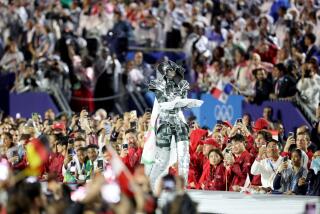The Greatest Costumes on Earth : Designer: To dress Cirque du Soleil, whose ‘Alegria’ plays in Costa Mesa through March, Dominique Lemieux lets imagination be her guide.
In the beginning, the acrobats refused to perform in feathers and lace; the pantomime artist said nyet to his new overcoat, and the lead chanteuse rejected her seemingly 10-ton tulle skirt.
Unruffled by such snags, designer Dominique Lemieux, who has been with the Montreal-based Cirque du Soleil since 1989, says that creating the 90 costumes for “Alegriia” was easy: “It was like something I already had inside of me for a long time.”
Drawing inspiration from the title--Spanish for joy, gaiety, merriment--Lemieux sketched at least 10 options for every character. Final selections were made after meetings with the performers, in which, she says: “We try to find the truth about them--how they move, how they relate to my drawings.”
The traveling “Alegriia,” in Costa Mesa on its sixth stop of a 12-city tour, expresses hope for humanity--despite some ugly truths conveyed by 16 “big old birds” dressed in jewel-encrusted silk jackets. Masks of leather and Lycra (tidied daily with Baby Fresh wipes) create their grotesque wrinkled faces.
The tally for one bird costume is more than $10,000, and dressing the entire flock requires 5,000 buttons, rhinestones and faux jewels (all hand-sewn), 1,600 synthetic flowers, 2,000 yards of plastic boning, 300 yards of silk brocade and 160 quarts of purple dye.
With $382,000 allocated for costumes, the creative staff can afford to be picky. Ninety percent of the fabrics are custom-dyed by a seven-member team ensconced in a Montreal technical school. Silk is the fabric of choice because it wears well, dyes beautifully, moves poetically and can be hand-washed and line-dried, a favorite Cirque maintenance technique. Trims attach with snaps or Velcro.
Most of the feathers are rendered in washable chiffon or organza.
Because of the extraordinary wear and tear, new costumes arrive from Montreal in a steady stream. Costumer Emery Comeau prowls the dressing rooms daily, looking for the minor repairs that must be made before every performance: Missing ornaments are replaced; ripped garments are mended, scuffed shoes are repainted.
On a recent sunny afternoon, his chores included hand-finishing a new gold lamee bodysuit for an acrobat and replacing the silver spangles on the back-up singer’s net skirt.
In all, 1,000 buttons and jewels are used for the two singers’ costumes. But with replacement parts filed away in the myriad drawers and boxes that line his costume-shop trailer, Comeau says, repairs rarely pose a challenge.
Performers, however, sometimes do.
Yves Fournier, director of the company’s Montreal costume shop, concedes that former Olympic gymnasts don’t take instantly to feathers, lace and lamee or leather masks and varnished-acrylic wigs.
“A wig and a mask add five pounds more. And most of the artists have never worn costumes before. So we have to teach them it won’t be a problem. For example, when the Russian trapeze team arrived, they said: ‘We can’t do our act with feathers in back and this big collar around our neck.’ Then the trainer tried one, and we changed some little things.”
The chanteuse was consoled with fewer layers of tulle. And the Russian clown had the last word. An understanding Lemieux explains: “We did a new coat for him, but he didn’t like it. It has to move in a certain way. He’s so used to being in one mood, if you put him in a costume that doesn’t have that mood, it doesn’t work. So the coat he has comes from Moscow.”
More to Read
The biggest entertainment stories
Get our big stories about Hollywood, film, television, music, arts, culture and more right in your inbox as soon as they publish.
You may occasionally receive promotional content from the Los Angeles Times.










